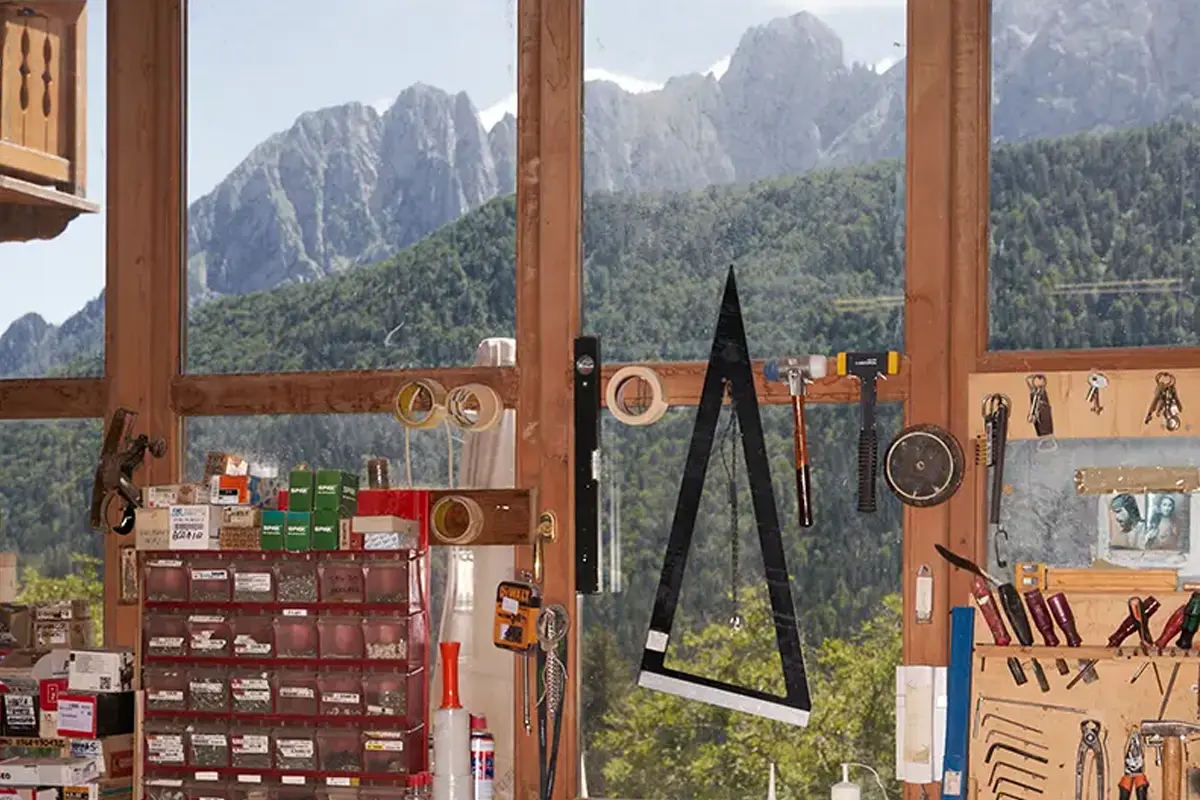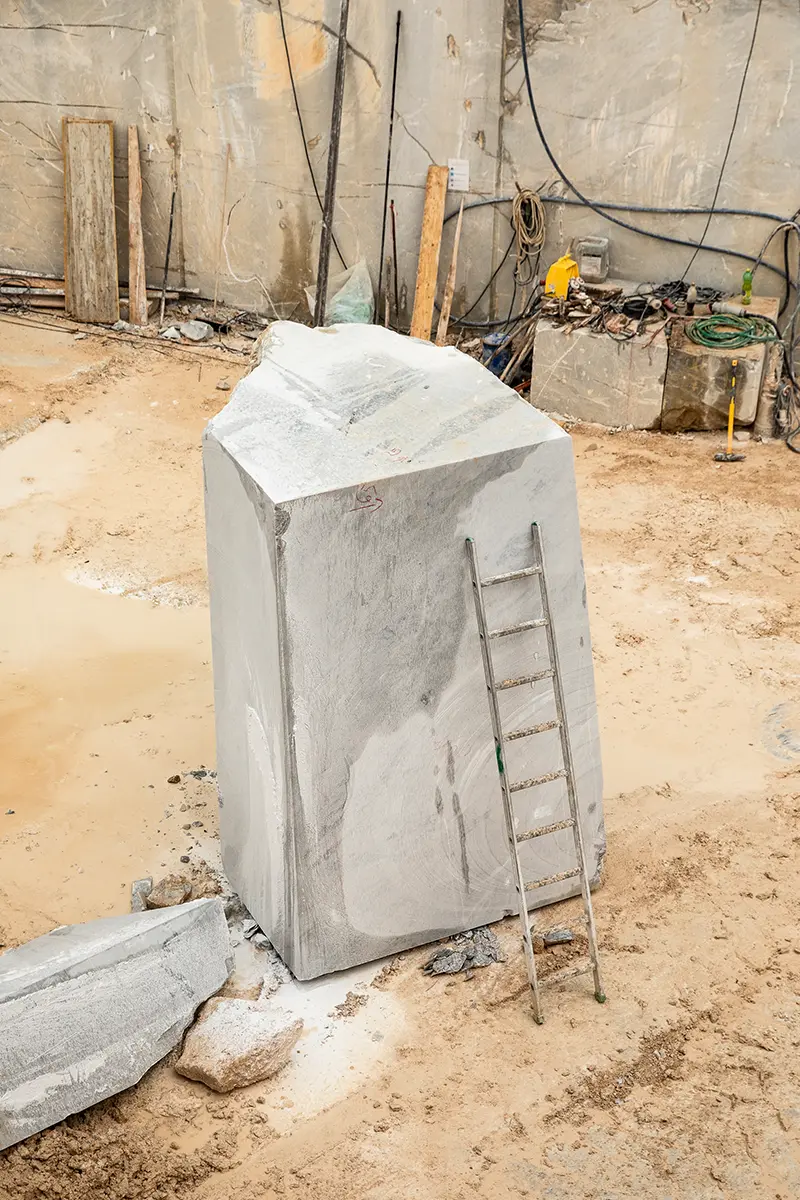Architect Debora Bordogni and designer Claudio Acquaviva found in Val Seriana the perfect ecosystem for their design studio where methodology and research hold sway
Lampoon presents Officina Magisafi
Enclosed between the quiet mountains overlooking the Val Seriana, moments away from the cities of Bergamo and Milan, there is a small village called Vertova. Surrounded by nature and bordered by the Serio, the stream which gives its name to the valley, Vertova is home to a former cotton mill which today hosts architect Debora Bordogni and designer Claudio Acquaviva’s all-encompassing architecture studio.
Founded in 2012, Officina Magisafi blends the most avant-garde design methodologies with the expertise and handcraft rooted in the Bergamasque fabric social and industrial. Every project is carefully followed from conception to realization. Creativity and rigor merge and coexist throughout the whole process, while the quality of raw materials and the mastery of the technique are the result of thorough research enabling functional and timeless solutions.
The silence of the valley is mirrored in the skillful and wise mastery of local artisans as well as in the meticulous and at the same time ingenious attitude of Officina. «The professionals we work with believe in a tangible know- how: when you really know what you’re doing, you don’t need to shout it», says Acquaviva. Harmonious compositions, solid structures, clean lines and fine finishes are among the ever-present features of each commission.
Officina Magisafi, The method
Structured as an artisan’s workshop, over the years the studio has put in place a methodological approach which is applied to every project and adjusted according to the specific client’s needs. Officina Magisafi is equipped with a management system conceived by the two founders which allows them to archive past projects and the relative documentation in an orderly manner, and at the same time to keep track of all the advancements in the ongoing construction sites.
Each client is provided with a personal QR code which gives access to a dedicated section of the studio’s portal with all kinds of information regarding the project, from floor plans to renders, from pictures of the construction site to any shift in the estimated budget. Commissioners are invited to take an active part in the conception of the project by selecting the materials and getting to know the craftsmen.
The studio’s archive is one of the pillars of Officina Magisafi. «It was a long, laborious work which took several years to be completed», Bordogni claims. Both physical and digital, it is based not only upon the codification of past projects, but also on a curated selection of design and architecture books and magazines whose pages are dotted with post-its and notes and serve as a source of inspiration for Bordogni and Acquaviva.
The ecosystem
«Concreteness is our strength. It is the basis of the architect’s work» Acquaviva claims. «The more materials are at the center of the project, the slower the project ages. The beauty of marble lasts forever», adds Bordogni. Thanks to the experience gained on construction sites when he used to be a house painter, Acquaviva acknowledges the importance of trusting and listening to the workers who physically create what he and Bordogni have conceived through sketches and renders.
«Of course aesthetics and details are important, but the technical aspects are key. We always start from the foundations, in every way». Officina Magisafi relies on the expertise and artistry of around fifteen suppliers and manufacturers located in the province of Bergamo. Stonemasons, blacksmiths, carpenters, painters and construction companies, among others, comprise the complex studio’s ecosystem.
Their know-how, passed down through generations and enhanced by the spirit of innovation which breathes in the Bergamo area, is what enables the realization of tangible solutions for all the different clients who turn to Officina Magisafi for their residential or commercial projects. A collaborative approach made possible through geographical proximity and the synergies activated by the workshop functioning as a catalyst for talent and production efforts.
Officina Magisafi and The marbles of Val Seriana
Marble is among the most widely used materials in Officina Magisafi’s projects. «We love employing natural materials in our projects. The difference becomes more noticeable with the passing of time», Acquaviva claims. Ceppo di grè, arabescato orobico and black slate are some of the most widespread types of marble extracted in the Bergamo area, although other rarer varieties can be found digging deeper into the mountains.
«Around February, a team of craftsmen led by a geologist comes from Asiago to carry out some surveys. They tell us in which direction to dig and how deep to go. We recently found a variety of Arlecchino marble, very colorful, about 110m past the area from which we extract the gray marble», explains Giovanni Fornoni, owner of Marmi Ardesio cave. Marble is extracted through an elaborate technique involving the use of blades, drills and high-precision instruments which allow the quarry miners to obtain large flawless blocks.
The marble processing – Officina Magisafi
The processing phases are carried out in the numerous workshops of stonemasons scattered around Vertova and the surrounding villages, where the marble slabs are carved through mechanical cutting or water cutting. «When we have to create non-standard shapes, for example washbasins which are usually curved, we use wooden templates», explains Luigi Paganessi, owner of marble shop Paganessi Marmi.
According to Acquaviva, one of the most complex phases when employing marble as surface coating is the creation of the filing cabinet. «It requires a lot of precision in the selection and combination of the plates as they are never the same. They all have different marbling». This technique – unlike the employment of huge single slabs – also allows to limit waste to a minimum. «We are attentive to this matter. We often reuse scraps or offcuts from old projects», he adds.
Over the years, Officina Magisafi has established itself in the Val Seriana and neighboring areas as a first-class design studio, but has also managed to make itself known outside the province of Bergamo, whose mastery is recognized throughout Italy and abroad . The fear that the know-how nurtured and handed down over the decades would disappear with the advent of new generations unaccustomed to manual work, has given rise to a desire in Acquaviva and Bordogni which could one day become reality. To found an academy dedicated to the study of traditional crafts, obviously according to the Officina method.
Officina Magisafi
Founded in 2012, Officina Magisafi is an all-encompassing architectural and design practice operating from the heart of the tucked-away Val Seriana, moments away from Bergamo and Milan. The strongly-felt Bergamasco identity of co-founders Claudio Acquaviva and Debora Bordogni has informed their distinctive concrete method. They focus on the tekne, the tangible mastery of architecture, materials, and spaces of living. The result, whether it be for private residences, commercial interiors or hospitality projects, is always functional spaces that speak of the intended user.




















